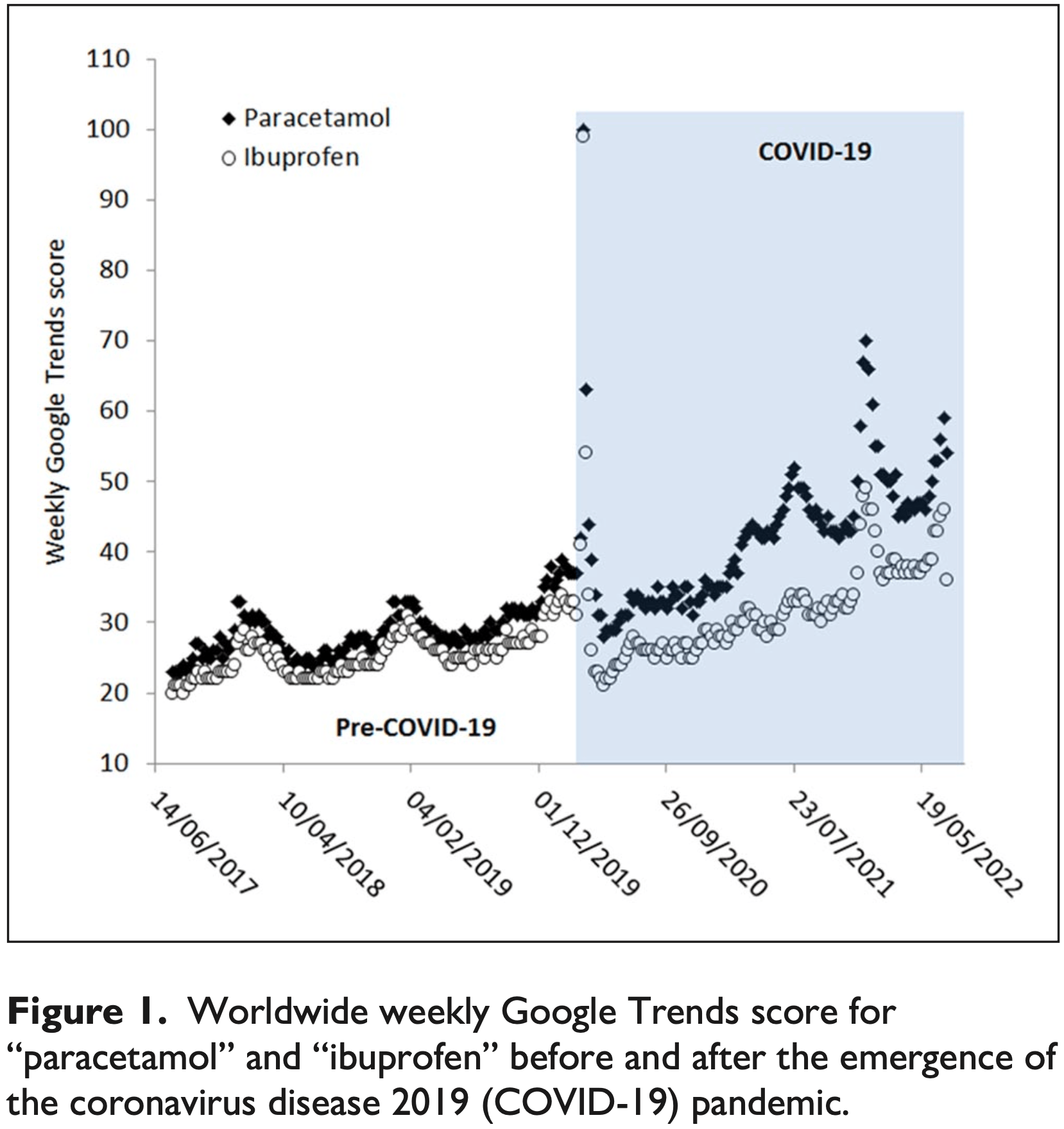
How Much has COVID-19 Contributed to Increase the Worldwide Consumption of Paracetamol and Ibuprofen? Evidence From an Infodemiological Analysis
et al., Hospital Pharmacy, doi:10.1177/00185787221125721, Sep 2022
2nd treatment shown to increase risk in
November 2020, now with p = 0.00000029 from 27 studies, but still recommended in 103 countries.
6,300+ studies for
210+ treatments. c19early.org
|
Infodemiological analysis showing a significant worldwide increase in Google searches for paracetamol (54%) and ibuprofen (24%) during the COVID-19 pandemic compared to pre-pandemic levels, suggesting dramatically increased consumption.
Paracetamol is also known as acetaminophen, Tylenol, Panadol, Calpol, Tempra, Calprofen, Doliprane, Efferalgan, Grippostad C, Dolo, Acamol, Fevadol, Crocin, and Perfalgan.
Study covers acetaminophen and ibuprofen.
Mattiuzzi et al., 24 Sep 2022, peer-reviewed, 2 authors, study period March 2020 - July 2022.
Contact: giuseppe.lippi@univr.it.
Abstract: 1125721
letter2022
HPXXXX10.1177/00185787221125721Hospital PharmacyMattiuzzi and Lippi
Letter to the Editor
How Much has COVID-19 Contributed
to Increase the Worldwide Consumption
of Paracetamol and Ibuprofen? Evidence
From an Infodemiological Analysis
Hospital Pharmacy
2023, Vol. 58(1) 7–8
© The Author(s) 2022
Article reuse guidelines:
sagepub.com/journals-permissions
https://doi.org/10.1177/00185787221125721
DOI: 10.1177/00185787221125721
journals.sagepub.com/home/hpx
Camilla Mattiuzzi1 and Giuseppe Lippi2
To the Editor,
Non-steroidal anti-inflammatory drugs (NSAIDs) are
commonly prescribed for treating viral infections, and their
usage is also widespread in patients with coronavirus disease
2019 (COVID-19), especially in those with milder illness.1
Several lines of evidence demonstrates, in fact, that early
anti-inflammatory therapy may prevent endothelia inflammation and the consequent risk of developing immunethrombosis, which would be associated with a substantially
enhanced prescription of these drugs, potentially leading to
medication shortage.2 We have hence planned an infodemiological analysis to establish whether the consumption of
some representative NSAIDs has increased all around the
world after the spread of COVID-19.
We accessed Google Trends (Google Inc. Mountain View,
CA, US) using the key words “paracetamol” (or acetaminophen) and “ibuprofen,” setting the geographical location to
“worldwide,” and limiting our search to the past 5 years (ie,
between July 2017 and July 2022). The weekly Google
Trends score for both terms “paracetamol” and “ibuprofen,”
thus mirroring their Web worldwide popularity, was divided
into 2 different periods, that is, “pre-COVID-19” (from July
2017 to February 2020) and COVID-19 (from March 2020 to
July 2022).3 The relative volumes of Google searches for
both terms over time was then analyzed with Spearman’s
correlation and compared between the COVID-19 and preCOVID-19 periods with Mann-Whitney test (Analyse-it
Software Ltd, Leeds, UK).
The main results of this worldwide infodemiological
analysis are summarized in Figure 1. A highly significant
Spearman’s correlation was found between time and weekly
Google Trends score of both paracetamol (r = .89; 95% CI,
0.87-0.92; P < .001) and ibuprofen (r = .78; 95% CI, 0.730.83; P < .001). Compared to the pre-COVID-19 period, the
median (and interquartile range; IQR) weekly Google Trends
score significantly increased by 54% for paracetamol (43
with IQR 34-47 vs 28 with IQR 26-31; P < .001) and by 24%
for ibuprofen (31 with IQR 27-37 vs 25 with IQR 23-27;
P < .001) during the COVID-19 pandemic, with Google
Figure 1. Worldwide weekly Google Trends score for
“paracetamol” and “ibuprofen” before and after the emergence of
the coronavirus disease 2019 (COVID-19) pandemic.
Trends score of paracetamol remaining constantly higher
than that of Ibuprofen (P < .001).
In conclusion, the results of this infodemiological analysis confirm that NSAIDs consumption may have dramatically increased on a worldwide scale after the emergence of
the COVID-19 pandemic, thus needing strengthened efforts
for monitoring appropriate prescription and limiting side
effects, as well as for preventing potential drugs shortage.
1
Service of Clinical Governance, Provincial Agency for Social and Sanitary
Services (APSS), Trento, Italy
2
University of Verona, Verona, Italy
Corresponding Author:
Giuseppe Lippi, Section of Clinical Biochemistry, University Hospital of
Verona,..
DOI record:
{
"DOI": "10.1177/00185787221125721",
"ISSN": [
"0018-5787",
"1945-1253"
],
"URL": "http://dx.doi.org/10.1177/00185787221125721",
"alternative-id": [
"10.1177/00185787221125721"
],
"author": [
{
"affiliation": [
{
"name": "Service of Clinical Governance, Provincial Agency for Social and Sanitary Services (APSS), Trento, Italy"
}
],
"family": "Mattiuzzi",
"given": "Camilla",
"sequence": "first"
},
{
"ORCID": "http://orcid.org/0000-0001-9523-9054",
"affiliation": [
{
"name": "University of Verona, Verona, Italy"
}
],
"authenticated-orcid": false,
"family": "Lippi",
"given": "Giuseppe",
"sequence": "additional"
}
],
"container-title": "Hospital Pharmacy",
"container-title-short": "Hosp Pharm",
"content-domain": {
"crossmark-restriction": true,
"domain": [
"journals.sagepub.com"
]
},
"created": {
"date-parts": [
[
2022,
9,
24
]
],
"date-time": "2022-09-24T11:49:18Z",
"timestamp": 1664020158000
},
"deposited": {
"date-parts": [
[
2023,
2,
14
]
],
"date-time": "2023-02-14T07:12:22Z",
"timestamp": 1676358742000
},
"indexed": {
"date-parts": [
[
2024,
5,
27
]
],
"date-time": "2024-05-27T22:34:45Z",
"timestamp": 1716849285675
},
"is-referenced-by-count": 6,
"issue": "1",
"issued": {
"date-parts": [
[
2022,
9,
24
]
]
},
"journal-issue": {
"issue": "1",
"published-print": {
"date-parts": [
[
2023,
2
]
]
}
},
"language": "en",
"license": [
{
"URL": "http://journals.sagepub.com/page/policies/text-and-data-mining-license",
"content-version": "tdm",
"delay-in-days": 0,
"start": {
"date-parts": [
[
2022,
9,
24
]
],
"date-time": "2022-09-24T00:00:00Z",
"timestamp": 1663977600000
}
}
],
"link": [
{
"URL": "http://journals.sagepub.com/doi/pdf/10.1177/00185787221125721",
"content-type": "application/pdf",
"content-version": "vor",
"intended-application": "text-mining"
},
{
"URL": "http://journals.sagepub.com/doi/full-xml/10.1177/00185787221125721",
"content-type": "application/xml",
"content-version": "vor",
"intended-application": "text-mining"
},
{
"URL": "http://journals.sagepub.com/doi/pdf/10.1177/00185787221125721",
"content-type": "unspecified",
"content-version": "vor",
"intended-application": "similarity-checking"
}
],
"member": "179",
"original-title": [],
"page": "7-8",
"prefix": "10.1177",
"published": {
"date-parts": [
[
2022,
9,
24
]
]
},
"published-online": {
"date-parts": [
[
2022,
9,
24
]
]
},
"published-print": {
"date-parts": [
[
2023,
2
]
]
},
"publisher": "SAGE Publications",
"reference": [
{
"DOI": "10.1007/s40264-021-01089-5",
"doi-asserted-by": "publisher",
"key": "bibr1-00185787221125721"
},
{
"DOI": "10.1177/00185787211046861",
"doi-asserted-by": "publisher",
"key": "bibr2-00185787221125721"
},
{
"author": "Cucinotta D",
"first-page": "157",
"journal-title": "Acta Biomed",
"key": "bibr3-00185787221125721",
"volume": "91",
"year": "2020"
}
],
"reference-count": 3,
"references-count": 3,
"relation": {},
"resource": {
"primary": {
"URL": "http://journals.sagepub.com/doi/10.1177/00185787221125721"
}
},
"score": 1,
"short-title": [],
"source": "Crossref",
"subject": [],
"subtitle": [],
"title": "How Much has COVID-19 Contributed to Increase the Worldwide Consumption of Paracetamol and Ibuprofen? Evidence From an Infodemiological Analysis",
"type": "journal-article",
"update-policy": "http://dx.doi.org/10.1177/sage-journals-update-policy",
"volume": "58"
}
